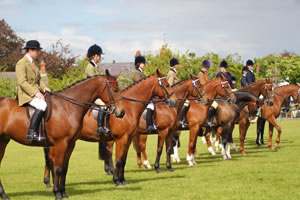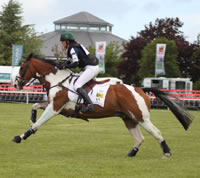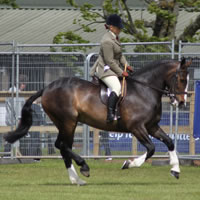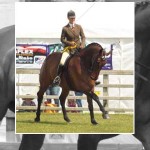Conditioning For The Show Ring With Baileys Horse Feeds
Written by Emma Short BSc (Hons)
Show horses’ waistlines are often a bone of contention but what is “show ring condition” and how can we best achieve it whilst maintaining the health and fitness of the horse.
 What is Condition?
What is Condition?
Horses carry different proportions of muscle and body fat according to their type and level of fitness or training. It is our aim, as horse owners, to ensure that these proportions are appropriate to the work we are expecting of the horse and adjust his diet and work load accordingly. Body condition scoring, using a numerical scale where 0 is “poor” and 5 is “obese”, can be a useful way of objectively assessing condition by looking at the horse’s neck, ribs and rump. Ideally you should be able to feel but not see the ribs and the horse should carry “top line” in the form of muscle not pads of fat, so correct work is imperative to encourage muscle development in the right places.
Whatever method of condition assessment you use, it should be both visual and “hands-on” – you need to feel through a thick coat in the winter, which can cover the true picture, and take a good step back from time to time to look at the whole horse. It is also useful to monitor your horse or pony’s bodyweight by using a weightape or, better still, a weighbridge. This will not only help you in your calculation of how much to feed but is particularly useful in assessing progress, especially when you are hoping to make considerable changes to your horse’s condition.
The Right Condition
 Having established your horse’s current condition, the next step is to decide whether that is how you would like him to stay or whether you need to make changes in order to help change his condition. For this you will also need to consider the work the horse is expected to undertake and the level of fitness he needs to attain. A show horse, for example, needs stamina and muscle tone for physical effort but may carry more “condition” than a three day eventer who has to gallop and jump.
Having established your horse’s current condition, the next step is to decide whether that is how you would like him to stay or whether you need to make changes in order to help change his condition. For this you will also need to consider the work the horse is expected to undertake and the level of fitness he needs to attain. A show horse, for example, needs stamina and muscle tone for physical effort but may carry more “condition” than a three day eventer who has to gallop and jump.
Show producers are continuously accused of presenting horses and ponies which are carrying too much body fat, in an attempt to ensure they have a “well rounded” appearance. It can be difficult balancing fitness and muscle tone with levels of body fat but it must be done; an overweight horse risks damage to joints and laminitis, as well as other health issues, and will often simply not exhibit the enthusiasm for work that a slimmer horse can. Those who seem to live on fresh air can be a nightmare to keep weight off but it is possible to maintain a balanced diet and control calorie intake, whilst those who struggle to keep the weight on must be fed with consideration to the limitations of the equine digestive system.
Putting it On
A common approach to promoting weight gain, is to feed more of the existing feed, or to add straights, such as barley or maize, and gradually the costs mount up but the condition we’re looking for may not. Not only is it unbalancing the ration by adding straight cereals to an already balanced compound feed, but we are also likely to be feeding ever increasing volumes which the horse’s stomach, with its limited capacity, simply cannot take.
What we risk when feeding large volumes in each feed is that some will pass on out of the stomach and small intestine before it has been fully digested. This presents a couple of problems – firstly the risk of digestive or metabolic upsets, such as colic or even laminitis, as a result of undigested starch reaching parts of the hind gut that it shouldn’t. Secondly, the feed will not be fully utilised so some of its nutrients will be lost, resulting in a simple waste of money! It’s therefore much more efficient, more cost effective, and safer, to feed for the job in hand by selecting a compound feed formulated for weight gain and condition.
Feeding frequent smaller amounts of a high calorie concentrated feed allows for less starch to be fed in order to promote the desired weight gain. Most reputable feed manufacturers also use cooking techniques, like micronising, which significantly increase the digestibility of the starch granules, ensuring that they are broken down in the foregut, where they should be, rather than reaching the hindgut.
Oil is another useful concentrated source of calories which is non-heating and helps to increase the energy density of the ration without significantly increasing volume. Specially developed high oil supplements are now available, which are more palatable and less messy than straight oil, and contain the necessary additional antioxidants which are required by the body to help it utilise the oil more efficiently.
The art with promoting weight gain, particularly for the show ring, is knowing when to stop! Continue to monitor your horse’s progress and consider the changing contribution that forage makes as the s
 pring grass comes through – be prepared to alter the diet again to one with a lower energy content once your horse is looking how you want him and finding it easier to maintain his condition during the spring and summer months.
pring grass comes through – be prepared to alter the diet again to one with a lower energy content once your horse is looking how you want him and finding it easier to maintain his condition during the spring and summer months.
Getting it Off
If your horse or pony is at the other end of the scale and you are always struggling to keep that tummy trim, then a different approach will be required. Feeding less than the recommended quantity of a low energy mix or cube will deprive your horse of essential nutrients needed for health and well-being whilst still providing some calories that he doesn’t need. The fact that your overweight horse is dull and lack lustre may not be so much to do with lack of energy in his diet but with a lack of vitamins and minerals. An ideal solution here is to choose a feed balancer.
These provide a very concentrated source of nutrients without extra calories and enable you to feed a balanced diet to ensure your horse is receiving all the nutrients for overall health and body maintenance. With correct work you should be able to encourage weight loss, whilst the protein content of the balancer will help promote muscle tone. So on a fully balanced diet, and losing some weight, your previously dull good doer should develop a brighter outlook on life!
Again, be prepared to change what you are feeding throughout the year to suit the changing weather conditions, routine and work load. For the exceptionally good doer, a balancer may be an excellent year round solution whilst for others, once the weight is lost, you may find that as work load increases and the nutrient content of the grass drops off in late summer, you need to reintroduce some calories by choosing a low or medium energy mix or cube. Remember that keeping things balanced is the key to optimising performance – feed your concentrate at the recommended rate and if it provides too many or too few calories, switch to something that gives you the energy levels you want when fed at the recommended rate.
The Role of Forage
We all know how important fibre is to maintain gut function and satisfy the horse’s natural requirement to chew, so forage, including hay, haylage and grass, will be the basis of a healthy diet but will also make a nutritional contribution which should not be forgotten. For example, feeding forage with a very low nutritional value may mean that, even when using the recommended quantities of a compound feed, the over all diet may not be balanced. Feeding a good quality hay or haylage that is soft and leafy, will ensure that your horse receives plenty of nutrients as well as essential fibre – this is especially important when feeding poor doers.
However, your fat pony or cob, for example, still has the same requirements for fibre and should be fed a clean, dust free forage that is stalkier and lower in nutrients to ensure that fibre intake is not restricted. Creativity is essential when feeding good-doers to ensure that even a limited amount of forage takes them plenty of time to eat; small-holed haynets and one net inside another will keep them occupied, whilst low calorie chaffs offer an alternative source of fibre which also takes up chewing time.
 Keeping it Right
Keeping it Right
Having achieved the level of condition that suits your horse and the work you require of him, careful monitoring will help you make the adjustments necessary to keep him that way. Try to avoid the massive condition fluctuations which may result from any “down time”, whatever the time of the year, as it will take you longer to achieve your “ideal” again. Keep a watchful eye, or use a weightape, and above all, be prepared to alter your regime accordingly to ensure your horse remains on a balanced diet and is fit and healthy to perform.
For more information or advice contact Baileys Horse Feeds on + 44(0)1371 850247, +44 (0)7885 065531 or visit www.baileyshorsefeeds.co.uk.
Category: Business Features, Disciplines, Features, Health, Seasons











